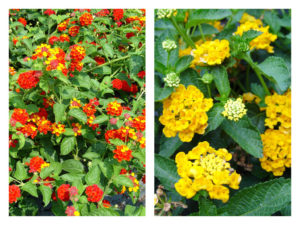Lantana
* Common name: Lantana
* Botanical name: Lantana camara
* What it is: Lantana is actually a woody shrub in the South, where it sometimes “seeds around” into unwanted areas. In the North, however, it’s a heat-tough, drought-tough, butterfly-attracting annual flower that dies after a convincing freeze in fall.
Plants have a trailing habit and come in a variety of bloom colors, most often in blends of gold, orange, red, and sometimes pink. The nickel-sized flower clusters look much like verbena.
The plants are moderately toxic, which makes them resistant to deer and rabbit browsing.
* Size: Depending on variety, plants grow one to two feet tall with a spread of 18 inches to nearly three feet.
* Where to use: Lantana can be massed in beds or borders, where they bloom non-stop all season. Because of their trailing habit, they also are ideal for hanging baskets or spilling out the side of large pots. Full sun is best.
* Care: Plant out after danger of frost passes in spring (mid-May or after). Work compost and timed-release flower fertilizer into soil at planting.
Keep soil damp the first few weeks to aid rooting, then water is needed only in extended dry spells. Supplemental liquid flower fertilizer each month throughout the growing season is helpful but not necessary.
Snip back any overly long branches during the growing season. Then yank and compost the plants after they freeze and die in fall, or move them inside before a freeze to grow as a houseplant in winter.
In pots, water daily in lieu of rain, and fertilize with a half-strength flower fertilizer every two weeks.
* Great partner: Red geraniums or large red begonias are good pot partners. Ornamental grasses, red shrub roses, and green or golden conifers are good landscape neighbors.








